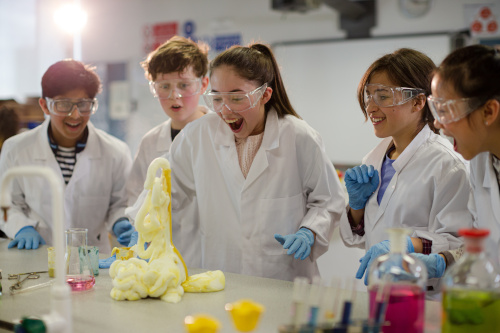It’s been said, “If a child can do advanced math, speak three languages, or receive top grades, but can’t manage their emotions, practice conflict resolution, or handle stress, none of that other stuff is really going to matter.”
As an educator, I’ve witnessed the truth of this statement firsthand. Whether they’re pursuing a future career or simply playing on a school sports team, it’s imperative that students know how to work together with the people around them. But lessons on social-emotional learning aren’t typically found in a classroom syllabus. So, how do we as educators actively foster these qualities in our students?
SEL skills can be implemented into any content area; it just takes a little intentionality and planning. By including aspects of SEL in hands-on, inquiry-based activities, we can help students develop these skills organically. Here are just a few science lessons where we intentionally taught social-emotional skills:
Balloon Rockets: The Balloon Rockets investigation is an engineering design investigation where students are challenged to design a lightweight rocket that is able to carry the greatest payload possible. This task can prove difficult for students and requires careful planning and collaboration to accomplish, because of this, Relationship Skills is a great area to reflect on after this lesson. Have students reflect on their experience through a Collaboration Y Chart to explore how teamwork can impact their success.
Lights Out: The Lights Out investigation is an engineering application that is completed after students complete the Light the Bulb experiment. Students learn not only how to light the light bulb, then use that knowledge to design, build and test a flashlight within set criteria and constraints. Because this is a sequence of investigations that could be run a few days in the class, students may be at different spots throughout the series and self-management is a very important skill to teach during more sustained inquiry experiences. Have students use Work Logs to keep track of what steps need to be completed as well as when each task is complete.
Related:
SEL is critical–but teachers rarely have time to address it
4 engaging strategies that promote student SEL
Mystery Powders: In the Mystery Powders investigation, students run chemical tests on multiple powders to identify their characteristics and use their observations to identify the mystery powder and catch a criminal. Throughout this investigation students have decisions to make: Do I carefully follow procedures? Or cut corners? These decisions can impact the outcome and quality of the data they collect as well as their conclusions’ credibility. Help students reflect on the impact of their decisions by using this Cause and Effect evaluation rubric.
What’s in Your Water? In this project-based learning unit, students learn all about water. They build watershed models, collect local water samples, and run tests to determine water quality. Because social awareness is at the heart of project-based learning, student use their knowledge of water to make the difference in the world. Students explore water issues that exist in the world, connect with industry experts and share with an authentic audience by raising money for a water charity of their choice.
A-MAZE-zing Spheros: The Sphero Maze investigation is a great introduction to programming and robotics. Students use computational thinking and block coding as they navigate their sphero through a maze and attempt to decrease their runtime. Students that are self-aware are not only able to recognize their strengths and weaknesses but can also see their potential. The Power of Yet can help students shift their fixed mindset to a growth mindset. This rubric serves as a reminder for students that they are capable of completing each challenge, they just might not be able to YET.
By helping our students grow into emotionally healthy individuals, we can give them the knowledge and resources they need to overcome any obstacle. The greatest accomplishments in human history have always required a bit of teamwork. With proper knowledge of SEL, who knows what our students will achieve together?
If you found these strategies helpful, be sure to check out this free resource from Van Andel Institute for Education: 5 Ways to Use Science to Teach Social-Emotional Learning.
- Learning the “why” behind the math: How professional learning transformed our teachers - January 16, 2026
- Cutting costs without cutting corners - January 15, 2026
- Reimagining teacher preparation to include student mental health supports - January 14, 2026

